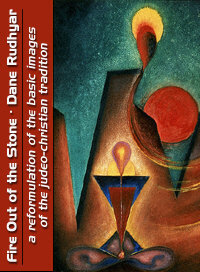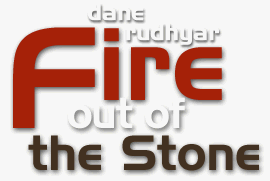 |
| Home | Bio | Art | Music | Literature | Civilization & Culture | Philosophy of Wholeness | Theosophy & Spirituality | Astrology |

FIRE OUT OF THE STONE A Reformulation of the Basic Images of the Judeo-Christian Tradition by Dane Rudhyar, 1962 1. Not to Repeat, But to Renew 2. The Essence and the Substance 3. To Become "More-Than-Man" 4. The Fatherhood of God 5. At the Center is Soul 6. Creation and Evolution 7. Crisis and Sin 8. The Coming-Together of God and Man • Page 1 • Page 2 • Page 3 • Page 4 • Page 5 9. Christ-Love: The Covenant with Individual 10. The Life of Mediation and its Paradox
: : :
This title was first published by Sevire, 1963. Cover for the online edition copyright © 2008 by Michael R. Meyer. : : : : : :
"Thy God is a cosumming fire." Duet. 4:25 "He shall baptize you with the Holy Spirit and with fire." Matthew 3:11 "I am come to send fire on the earth." Luke 12:49
: : :
|

8. THE COMING-TOGETHER OF GOD AND MAN - page 4
"God becomes as we are, so that we may be as He is."
William Blake — There is no Natural Religion; 1788 The Mosaic CovenantThe symbolic period extending from Abraham to Moses is, I repeat, a period of transition, a "critical state" in the soul's evolution. The potential of individual selfhood inherent in the human seed, when overshadowed or guided by the strength of the evolutionary process, is stirring increasingly. The first stirrings lead to the formation of the ego, which has its place as a temporary framework for the growing sense of self, of "I-am-ness." Then the divine Principle of the I AM Itself "descends" into the consciousness of the ego; and "Moses" begins his mission. The Hebrew name "Mo-she" can be interpreted as the "fire of the mind", as the letter shin (and the vocal sound "sh" in many languages) symbolizes the element of "fire". Moses came from the line of Levi, the third son of Jacob-Israel; and the symbolism of the number 3 is here significant, for the third aspect of the Trinity is that Holy Fire which illumines the individual person (cf. the descent of the Holy Spirit as "tongues of fire" upon Jesus' Apostles at the Pentacost). Thus the House of Levi was later consecrated to the service of God and the Levites carried the Tabernacle and acted as priests. The name "Levi" seems to mean in Hebrew "attached or joined" — hence the link between God and this elect people. Moses' mother, in order to save his life after Pharaoh ordered that all newborn male children of the Israelites be cast into the Nile, placed him in a water-tight "ark" after birth and hid it in the flags along the river's banks, where the Pharaoh's daughter found and subsequently adopted him. Here again we find the symbolism of a water-tight ark, as in Noah's Ark; but the waters are now those of the Nile, the river upon which the whole of Egypt depends for life. This long stream symbolizes the central canal of the spine and the cerebro-spinal fluid in which the central nervous system bathes. (In Sanskrit, nila means "blue" and the two original streams which converge at Khartum in the Sudan to form the main river are called the Blue Nile and the White Nile. Blue is the color associated with the Principle of individual selfhood operating through and in association with the mind: manas}. After 40 years at the court of Pharoah (the number 40 originally referred to the 40 weeks of gestation) Moses flees to the Sinai peninsula, after killing an Egyptian in righteous anger and fearing for his life. Mt. Horeb is called "the mountain of God" and, at the apex of the triangular Sinai peninsula pointing south (i.e., "downward"), it represents the focal point for the further "descent" of God into the human soul. Here "the angel of the LORD appears unto him in a flame of fire out of the midst of a bush," and the LORD speaks, revealing to Moses His new name: I AM THAT I AM; that is, presenting Himself as the Principle of individual selfhood in its ultimate divine aspect. The Burning Bush, and the rod which changes into a serpent — the symbol which the divine I AM gives to Moses as proof of the covenant — evidently refer to what Hindu yoga calls the rise of the Serpentine Power (Kundalini) along man's spine. Later on we see the Israelites, led by Moses through the wastelands of this same Sinai peninsula, being guided by a "pillar of fire" — another reference to the vertebral column. (The Doric column also had a similar and profound meaning in Greek esoteric philosophy.) After God reveals Himself to Moses as the I AM Principle, He also confides to Moses His "name of power", JHVH (the fourfold power of life as a manifestation of the One, the Integrator), which name He had apparently not revealed to Abraham, Isaac or Jacob (Exodus 6:3). He repeats the terms of the covenant with Abraham and charges Moses to lead the Israelites out of Egypt. The details of the whole Exodus are well known, from the parting of the Red Sea to the entrance into the Promised Land. Moses, as a thoroughly individualized and conscious Agent of God, hears God speak to him "face to face, as a man speaketh unto his friend", and he receives the Tables of the Law. However, while the first Tables were "the work of God, and the writing was the writing of God, graven upon the Tables", the second Tables, after the Israelites had relapsed into pagan worship and Moses had broken the first, were "hewn" out of the rock by Moses; a very significant change. Later on Moses and Aaron, instead of "speaking unto the rock" that it might give water, as God had bid them do, "smote the rock twice", having apparently no faith in the power of the spoken word. For this lack of faith both leaders are excluded from the Promised Land, to which Joshua instead leads the people. The several failures of Moses and of the Israelites are symbolic of the basic difficulties man has to meet during the final stages of the crisis of soul-individualization. If Moses the Agent of God fails, it is because of the incomplete surrender of his ego-will to the will of the "individual soul". The means (ego) are emphasized as against the end (the "individual soul"). The striking of the rock for water is characteristic of the ego-will's reliance upon technique (or technology!) and showmanship. One must impress one's public! — and Moses probably remembered the earlier show he made at Pharaoh's court to best the court magicians. However, after the soul has become individualized by the direct Presence of God and the face-to-face communication with Him, such muscular performances as striking a rock and, before that, breaking the Tablets, made by God, in a childish act of fury and righteous indignation (a Mosaic trait!), become failures with serious consequences. The people had regressed to the worship of the Golden Calf and Moses was violent with anger; but he too regressed to the use of magical tricks when he smote the rock as a showman would. He had not acquired total faith in the power of individualized soul-existence at the level of mind-energies — a transforming power manifest in the utterance of the word, indeed the very Power of the Fatherhood of God. In contrast we see Jesus entirely pervaded by this total faith. He very simply controls the elements by words; he commands Lazarus rise out of the sepulchre; he heals by saying: "Be thou whole". The Mosaic Covenant produces a set of laws because God meets individualized man in mind and mind is the formative principle establishing patterns of order. The basic laws God gives to Moses are principles of right behavior and right relationship to be effective during the period in which mankind as a whole struggles collectively through the process of soul-individualization. By "struggling collectively" I mean here struggling within the framework of definite religious-cultural and social-national traditions. Individuals can, of course, outrun the collectivity in which they are born. To them paths of occult and mystic training, "schools of prophethood", etc., are made available whose origin essentially (even if not literally) goes back to the "vineyards" of post-Diluvian times. But these individuals, who herald in some way the coming of the "New Covenant" of Christ, have had to pass through the process of individualization, through its "dark night of the soul", and its often seemingly insurmountable pitfalls and ordeals — for 40 days, weeks, months, years, or even lives!  Home | About | Calendar | Ephemeris Charts | Art Gallery | Library | Resources Shop | Rudhyar Archival Project | Help Web design and all data, text and graphics appearing on this site are protected by US and International Copyright and are not to be reproduced, distributed, circulated, offered for sale, or given away, in any form, by any means, electronic or conventional. See Notices for full copyright statement and conditions of use. Web design copyright © 2000-2004 by Michael R. Meyer. All Rights Reserved. |